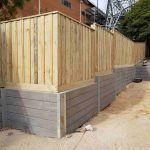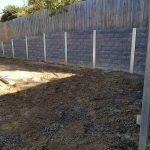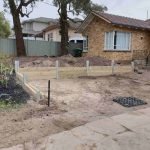Introduction
Building a retaining wall can be one of the most intelligent choices for landscape management, specifically when handling sloped terrains. However what should http://kameronduss330.iamarrows.com/step-by-step-retaining-wall-setup-process-explained you get out of a retaining wall construction team? The response depends on comprehending their proficiency, the products they use (like timber sleeper and concrete sleeper), and how they deal with the job from start to finish. This post aims to guide you through every element of hiring a professional retaining wall building group, ensuring that your investment pays off in longevity and quality.

What to Expect from a Retaining Wall Building And Construction Team
When you're considering installing a retaining wall, the first question that comes to mind is probably about the building and construction team. What qualifications do they have? How knowledgeable are they with different kinds of walls like those made from timber sleepers, concrete sleepers, or perhaps using H beams?
The Significance of Professional Expertise
A professional building and construction group will not only provide physical labor but likewise invaluable know-how. They must offer insights into:
- Material Choice: Understanding whether timber sleeper or concrete sleeper is suitable for your project. Design Factors to consider: Knowing how high and large the wall requires to be based upon soil type and slope. Regulatory Compliance: Ensuring all work meets local codes and permits.
Understanding Maintaining Walls: Types and Materials
Types of Retaining Walls
Retaining walls been available in several types:
Gravity Walls- Depend on their weight to withstand pressure.
- Utilize take advantage of gained by extending backward into the earth.
- A variation of cantilever walls that include additional reinforcement.
- Often used for waterside jobs; terrific for limited space situations.
- Use cables anchored in soil or rock behind the wall for included support.
Materials Utilized in Retaining Wall Construction
When picking products, consider your visual choices in addition to structural stability:
Concrete Sleepers- Durable, resistant to weathering, and typically pre-cast.
- A more natural look but may need more maintenance over time.
- Offers an organic visual however can be costly.
- Easy to install and offered in various styles.
- Utilized for larger walls needing additional strength.
The Preliminary Assessment Process
Setting Up Your First Meeting
Your interaction with the building and construction group starts here; it's important to put down expectations:

- Discuss your objectives for the maintaining wall. Outline your spending plan constraints. Explore different product choices (timber sleeper vs concrete sleeper).
Site Assessment
An extensive site assessment is essential:
- The group must evaluate soil conditions. Assess drain concerns that might impact wall stability. Identify any local regulations impacting construction.
Design Phase: What You Must Know
Drafting Plans and Blueprints
During this phase, expect comprehensive conversations about style elements:
- Height, length, and looks need to be finalized. The importance of drainage systems ought to be highlighted.
Material Choices Explained
You'll have several options when it comes to materials:
|Product Type|Pros|Cons|| --------------------|---------------------------|----------------------------|| Timber Sleeper|Affordable, Natural Look|Less resilient with time|| Concrete Sleeper|Strong, Weather Resistant|Higher initial expense|| H Beam|Incredibly sturdy|Needs specialized labor|
Permitting: Essential Actions Before Building Begins
Obtaining authorizations isn't just red tape; it's important for legality:
- Understand local zoning laws governing structures on slopes. Your specialist will typically assist with the paperwork needed.
Preparing the Website for Construction
Clearing and Grading the Area
Before any actual building occurs:
The location must be cleared of vegetation. Proper grading guarantees water flows away from your home rather of pooling around the base of the wall.Excavation Work: A Crucial Step
Excavation is not simply digging; it's strategic preparation!
Depth must accommodate both wall height and drainage needs. Secure any essential disintegration control procedures throughout this stage.Construction Day: Expectations Vs Reality
Workforce Coordination
Expect a well-coordinated team on-site:
Each member must know their function clearly-- be it excavating, blending concrete, or putting together lumber sleepers. Communication is essential; ensure everybody's on board with security protocols.Material Delivery Timing and Handling
Materials like concrete sleepers or H beams must arrive prompt to prevent delays:
- Ensure that delivery trucks can access tight areas quickly without destructive existing landscaping.
Quality Control During Construction
Regular Assessments by Professionals
As building and construction progresses, routine checks are vital:
Inspect structure work before moving forward. Ensure walls are plumb and level at each stage-- this avoids future structural issues.Adaptability During Build Process
Sometimes things do not go according to plan! Here's where flexibility shines:
Be got ready for unforeseen challenges like poor soil conditions necessitating style changes.
Trust your professional group; they're there for a reason!
FAQs About Retaining Wall Construction Teams
Q1: For how long does it normally take to construct a keeping wall?
A: Usually, building a retaining wall might take anywhere from a few days as much as several weeks depending upon size, complexity, and weather conditions.
Q2: What sort of upkeep do retaining walls require?
A: Maintenance can vary based on products used-- wood sleepers might need sealant every couple of years whereas concrete sleepers might require less frequent attention unless cracks appear.
Q3: Can I develop my own maintaining wall?
A: While DIY is possible, getting professionals makes sure proper design adherence and structural integrity-- specifically crucial if you lack experience in landscaping or engineering principles!
Q4: Do I need drainage behind my retaining wall?
A: Definitely! Correct drainage keeps pressure off your wall structure preventing bulging or collapse over time.
Q5: Can I repurpose old wood or bricks for my maintaining wall?
A: Yes! Repurposing products can include character-- but ensure they're structurally sound enough for long-lasting use!
Q6: What happens if I do not get licenses before building?

Conclusion
In summary, understanding what to expect from a retaining wall building and construction group goes far beyond just hiring workers; it encompasses whatever from initial assessments regarding material options such as wood sleepers versus concrete sleepers all the method through job conclusion where quality control remains critical throughout every step taken! When you align yourself with seasoned professionals who comprehend these complexities better than anybody else-- you'll find peace-of-mind knowing that not just does your home appearance terrific however also stands strong against nature's forces!